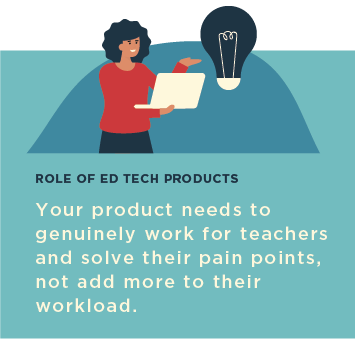EdTech: Supporting Teachers vs. Replacing Them
Teaching is not a simple transfer of information. It’s eye contact during a tough day. It’s sensing confusion before a hand goes up. It’s the subtle art of knowing when to push, when to pause, and when to let a student wrestle with an idea just a little longer. Real teaching is relational, responsive, and deeply human.
AI and technology, on the other hand, don’t do nuance. AI doesn’t notice when a student’s confidence is slipping or when a breakthrough is just a well-timed question away. As Dan Meyer points out, efforts to build a “teacher” out of code, like Khan Academy’s Khanmigo, lead to flat, robotic interactions that miss the mark due to a lack of understanding of the real-world scenarios in which students and teachers find themselves.
That’s the problem. Real teachers respond to people. AI responds to inputs. And until a chatbot can spark joy, challenge bias, or build trust, it’ll remain a tool, not a teacher.
Are Teachers Using AI & Technology How You Think They Are?
According to an EdWeek survey, about one-third of K–12 teachers have tried AI in the classroom. They’ve experimented with it in an effort to survive their growing workload of lesson plans, rubrics, feedback, emails to parents, and all the other “invisible” tasks that eat into their nights and weekends.
But don’t mistake teachers’ willingness to experiment for blind adoption. Many teachers are approaching EdTech products and AI tools with caution. There is real concern about students using AI to cheat, about AI generating inaccurate or biased responses, about schools moving too quickly without offering the support teachers need to keep up, and whether new EdTech products will overshadow the critical role educators play.
When EdTech Misses the Mark: The 5% Problem
On paper, the numbers look great. Some EdTech programs report significant learning gains, like months of growth in just a few weeks. But look closer, and you’ll find a catch. Those gains usually come from only 5% of students. The ones who use the tool exactly as recommended. And more often than not, these students are the ones who are already ahead of the curve: they come from higher-income families, are higher-performing, and have plenty of support at home.
When usage depends on motivation, resources, or whether a teacher believes in the platform, you risk ending up with tools that widen gaps instead of closing them. And when schools roll out new technology without giving teachers enough time, training, or support, even the most promising platform can fall flat.
EdTech companies need to support schools and teachers throughout this implementation phase in meaningful ways. And once the product is in teachers’ hands, it needs to genuinely work for them and solve their pain points, not add more to their workload.
What Betting on Teachers Actually Looks Like
Successful EdTech products give teachers what they desperately need: time. According to McKinsey, innovative AI tools can save teachers up to 13 hours a week. That’s the equivalent of six extra days of instruction per month. Imagine what educators could do with that margin.
We’ve seen what’s possible. Automation that makes grading a breeze. Tools that adapt lessons based on student progress, but still leave the final call to the teacher. This is what good EdTech looks like. Not a teacher replacement. A supportive relief. A way to offload the repetitive stuff, so teachers can focus on what only they can do.
As Dan Meyer aptly puts it: you either bet on teachers, or you try to build one. And to his point, no one’s built a convincing digital teacher yet. Because the magic of teaching lives in the unpredictable, intuitive moments that no algorithm can replicate.
What This Means for EdTech Product & Marketing Teams
When you center humans in your EdTech product, you build something that actually works in the classroom. So, bet on teachers and build tools that lighten their load and respect their role.
In product development, that means co-creating with educators, not just testing an already produced product on them. It means designing features that reduce friction, incorporating educator input, honoring teacher autonomy, and supporting real-life classroom workflows.
In marketing, it means focusing on what teachers actually want to hear: we see you, we’ve got your back, and this tool will make your job easier, without taking it away from you.
And to do any of that well? You need people in the room who’ve actually stood in front of a classroom. People who understand pacing guides and parent emails, and the emotional calculus of teaching. Because if your goal is to support teachers, you need to speak to their experiences. You need to speak their language.
An EdTech Marketing Company Who Gets It
The Clever Lucy leadership team has over 35 years of combined experience in the K-12 and higher educational spaces. We know how to center teacher voices because we’ve been them, we’ve collaborated with them, and we value the impact they make in shaping the next generation.
Whether you’re an EdTech startup looking for go-to-market support or an established brand ready to deepen your connection with educators, we’re here to help you build smarter strategies, stronger stories, and EdTech solutions that support teachers, vs replace them.
Book a 15-minute discovery call to learn how.


